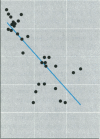Abstract
We studied the effect of polychlorinated biphenyls (PCBs) on hepatic porphyrin accumulation in female Sprague-Dawley rats by feeding them diets containing 2,3,7,8-tetrachlorodibenzo-p-dioxin (TCDD), 2,2',4,4',5,5'-hexachlorobiphenyl (PCB 153), 2,3,3',4,4',5-hexachlorobiphenyl (PCB 156), 3,3',4,4',5-pentachlorobiphenyl (PCB 126), or combinations of the single PCB congeners with TCDD for 13 weeks. A dose-dependent increase in hepatic porphyrin accumulation occurred after TCDD, PCB 126, or PCB 156 administration, reaching maximal levels of about twice control values. The lowest dose levels for which a significant increase in hepatic porphyrin accumulation was found were 0.7 microgram TCDD/kg diet, 50 micrograms PCB 126/kg diet, or 6 mg PCB 156/kg diet. These doses are equivalent to 47 ng TCDD/kg/day, 3.2 micrograms PCB 126/kg/day, and 365 micrograms PCB 156/kg/day. Relative potencies for hepatic porphyrin accumulation, using TCDD as a reference, ranged from 0.015 to 0.06 for PCB 126 and from 0.0001 to 0.0003 for PCB 156. CYP1A2 activities significantly correlated with hepatic porphyrin levels, with coefficients of 0.629, 0.483, or 0.808 for TCDD, PCB 126, or PCB 156, respectively. Administration of PCB 153 alone did not result in hepatic porphyrin accumulation. Co-administration of PCB 153 and TCDD revealed a strong synergistic effect on porphyrin accumulation (about 800 times control levels). This synergistic effect was significant in rats fed diets containing any combination of PCB 153 with TCDD. Uroporphyrin III and heptacarboxylic porphyrin were accumulated in porphyrinogenic livers. These results suggest that TCDD induction of CYP1A2 may be involved, leading to oxidation of uroporphyrinogen III to uroporphyrin III, in combination with an increase in delta-aminolevulinic acid synthetase induced by PCB 153. Under porphyrinogenic conditions, an inhibitor of CYP1A2 activity may also be formed. The interactive effects on porphyrin accumulation after co-administration of dioxinlike and non-dioxinlike compounds may have significant implications for the risk assessment of these chemicals.
Full text
PDF
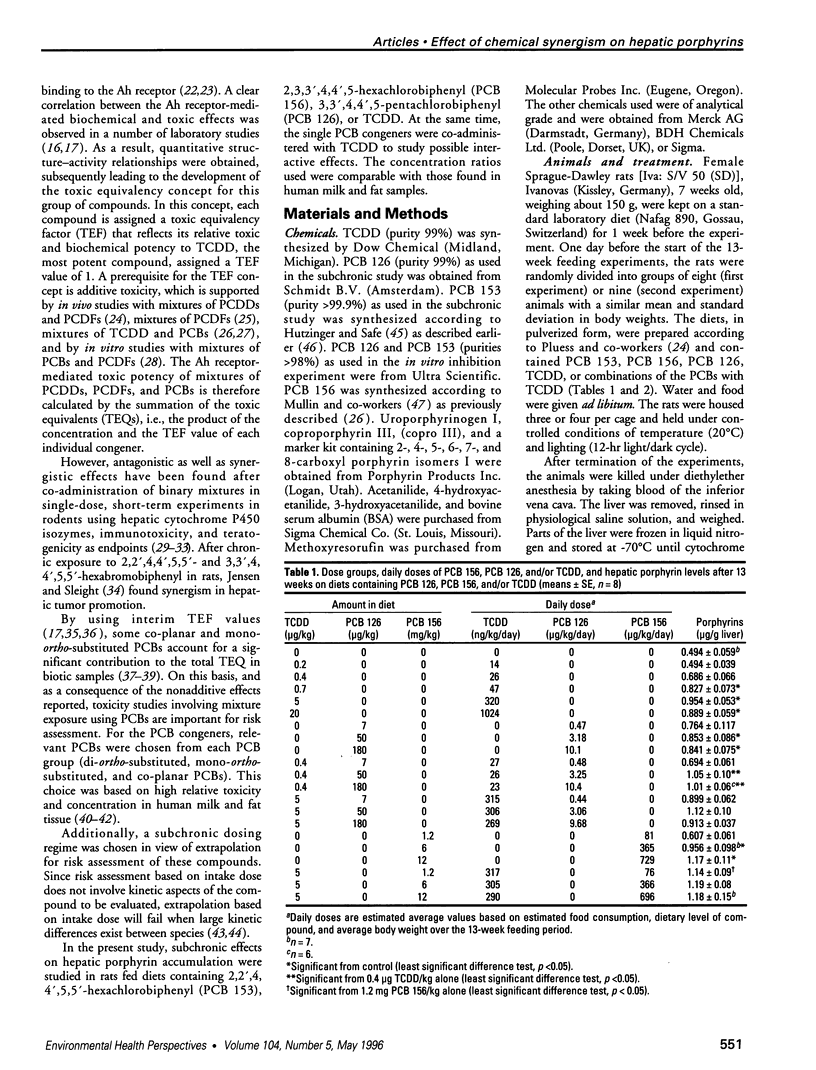

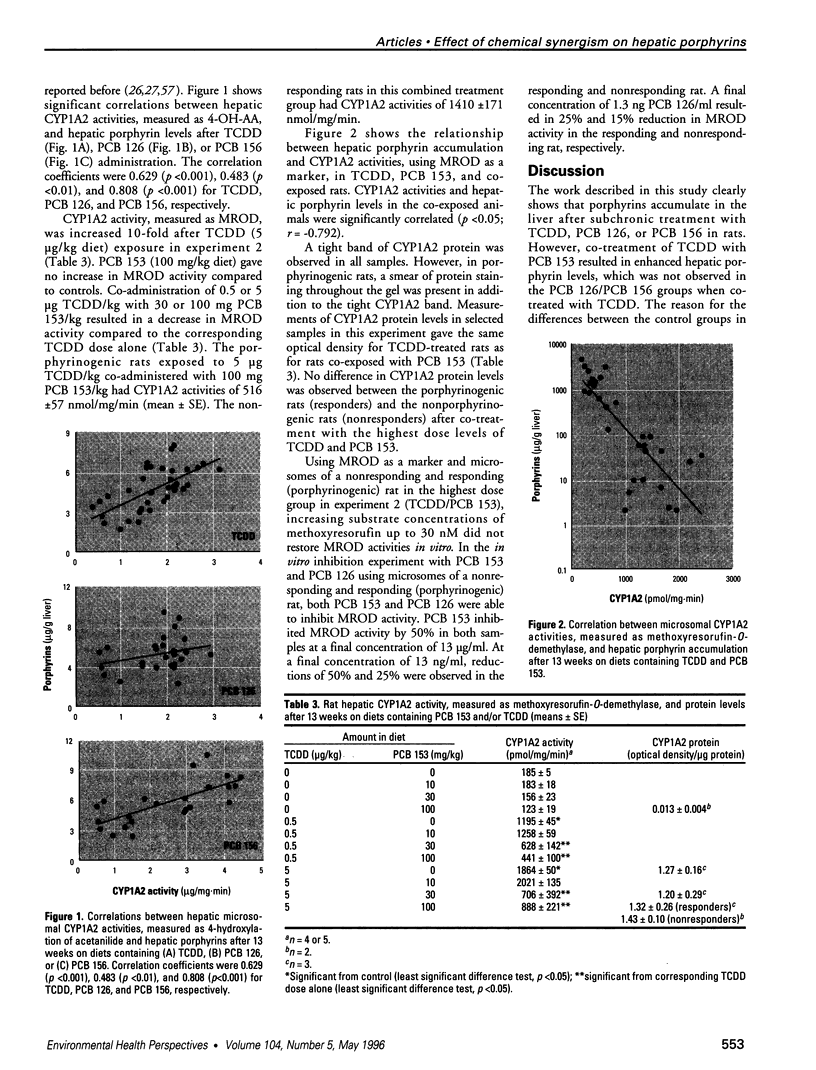

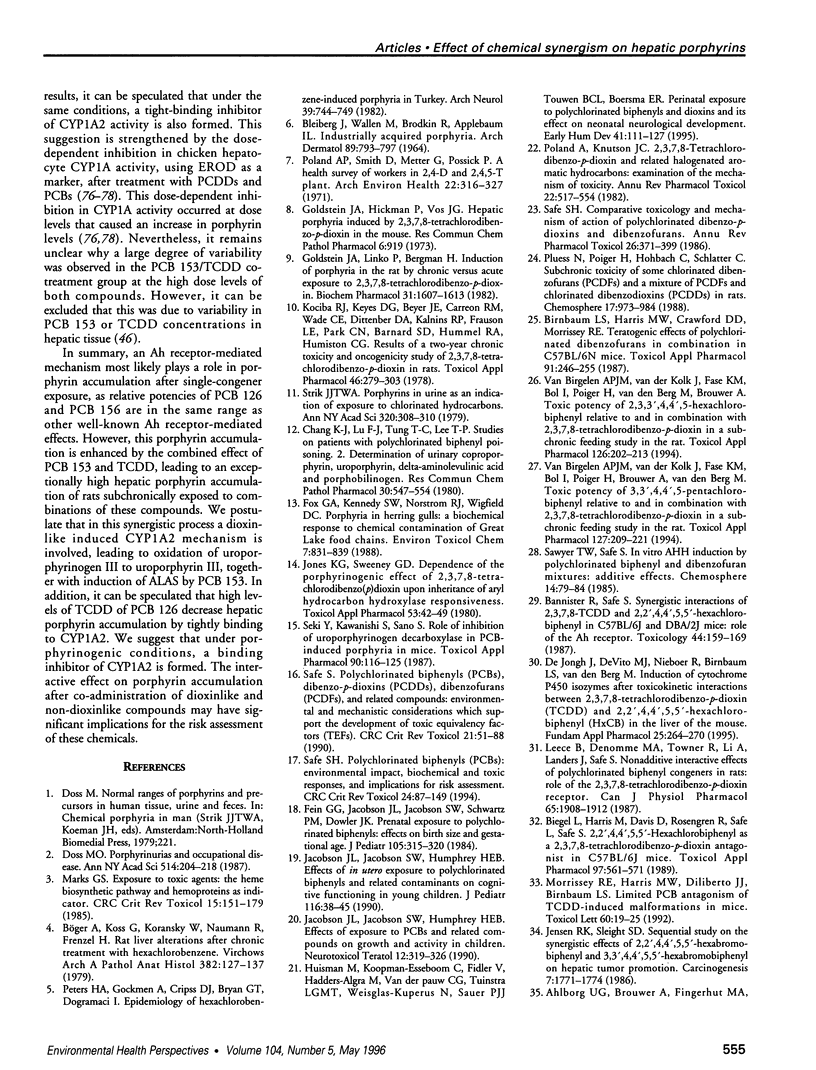
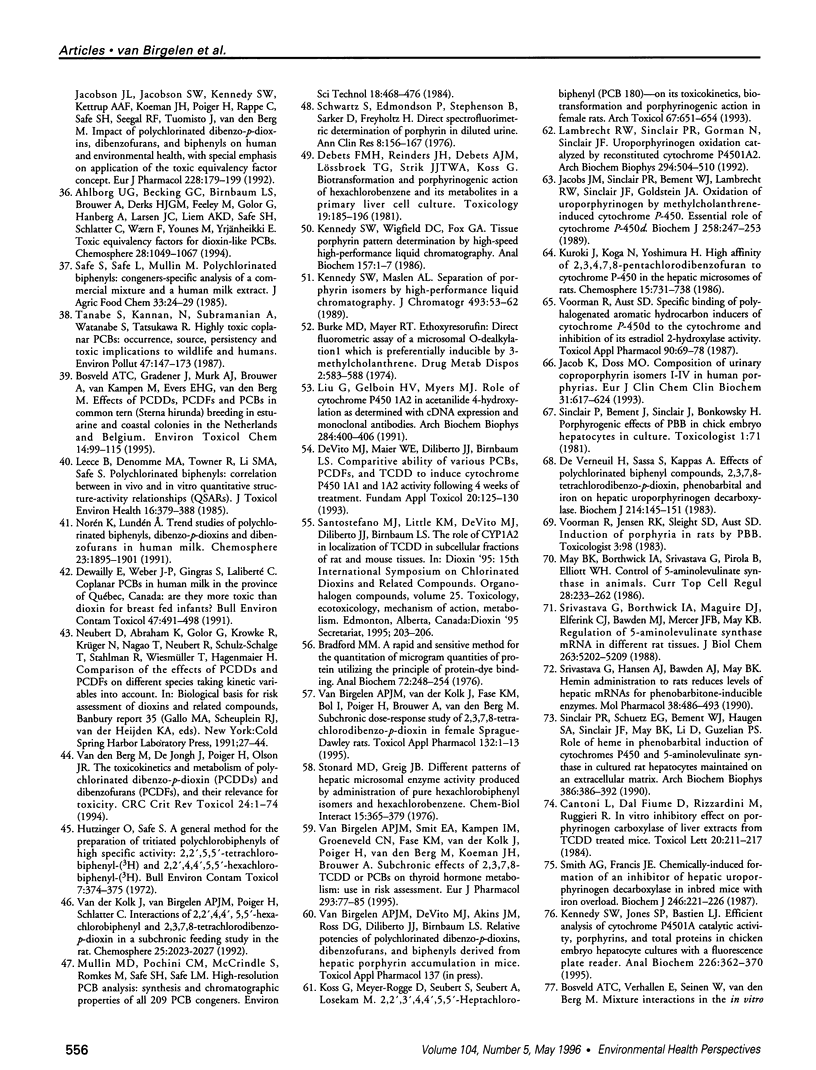

Images in this article
Selected References
These references are in PubMed. This may not be the complete list of references from this article.
- Ahlborg U. G., Brouwer A., Fingerhut M. A., Jacobson J. L., Jacobson S. W., Kennedy S. W., Kettrup A. A., Koeman J. H., Poiger H., Rappe C. Impact of polychlorinated dibenzo-p-dioxins, dibenzofurans, and biphenyls on human and environmental health, with special emphasis on application of the toxic equivalency factor concept. Eur J Pharmacol. 1992 Dec 1;228(4):179–199. doi: 10.1016/0926-6917(92)90029-c. [DOI] [PubMed] [Google Scholar]
- BLEIBERG J., WALLEN M., BRODKIN R., APPLEBAUM I. L. INDUSTRIALLY ACQUIRED PORPHYRIA. Arch Dermatol. 1964 Jun;89:793–797. doi: 10.1001/archderm.1964.01590300021006. [DOI] [PubMed] [Google Scholar]
- Bannister R., Safe S. Synergistic interactions of 2,3,7,8-TCDD and 2,2',4,4',5,5'-hexachlorobiphenyl in C57BL/6J and DBA/2J mice: role of the Ah receptor. Toxicology. 1987 May;44(2):159–169. doi: 10.1016/0300-483x(87)90146-6. [DOI] [PubMed] [Google Scholar]
- Biegel L., Harris M., Davis D., Rosengren R., Safe L., Safe S. 2,2',4,4',5,5'-hexachlorobiphenyl as a 2,3,7,8-tetrachlorodibenzo-p-dioxin antagonist in C57BL/6J mice. Toxicol Appl Pharmacol. 1989 Mar 1;97(3):561–571. doi: 10.1016/0041-008x(89)90261-5. [DOI] [PubMed] [Google Scholar]
- Birnbaum L. S., Harris M. W., Crawford D. D., Morrissey R. E. Teratogenic effects of polychlorinated dibenzofurans in combination in C57BL/6N mice. Toxicol Appl Pharmacol. 1987 Nov;91(2):246–255. doi: 10.1016/0041-008x(87)90105-0. [DOI] [PubMed] [Google Scholar]
- Bradford M. M. A rapid and sensitive method for the quantitation of microgram quantities of protein utilizing the principle of protein-dye binding. Anal Biochem. 1976 May 7;72:248–254. doi: 10.1016/0003-2697(76)90527-3. [DOI] [PubMed] [Google Scholar]
- Burke M. D., Mayer R. T. Ethoxyresorufin: direct fluorimetric assay of a microsomal O-dealkylation which is preferentially inducible by 3-methylcholanthrene. Drug Metab Dispos. 1974 Nov-Dec;2(6):583–588. [PubMed] [Google Scholar]
- Böger A., Koss G., Koransky W., Naumann R., Frenzel H. Rat liver alterations after chronic treatment with hexachlorobenzene. Virchows Arch A Pathol Anat Histol. 1979 May 31;382(2):127–137. doi: 10.1007/BF01102869. [DOI] [PubMed] [Google Scholar]
- Cantoni L., dal Fiume D., Rizzardini M., Ruggieri R. In vitro inhibitory effect on porphyrinogen carboxylyase of liver extracts from TCDD treated mice. Toxicol Lett. 1984 Feb;20(2):211–217. doi: 10.1016/0378-4274(84)90149-8. [DOI] [PubMed] [Google Scholar]
- Chang K. J., Lu F. J., Tung T. C., Lee T. P. Studies on patients with polychlorinated biphenyl poisoning. 2. Determination of urinary coproporphyrin, uroporphyrin, delta-aminolevulinic acid and porphobilinogen. Res Commun Chem Pathol Pharmacol. 1980 Dec;30(3):547–554. [PubMed] [Google Scholar]
- De Jongh J., DeVito M., Nieboer R., Birnbaum L., Van den Berg M. Induction of cytochrome P450 isoenzymes after toxicokinetic interactions between 2,3,7,8-tetrachlorodibenzo-p-dioxin and 2,2',4,4',5,5'-hexachlorobiphenyl in the liver of the mouse. Fundam Appl Toxicol. 1995 May;25(2):264–270. doi: 10.1006/faat.1995.1062. [DOI] [PubMed] [Google Scholar]
- De Verneuil H., Sassa S., Kappas A. Effects of polychlorinated biphenyl compounds, 2,3,7,8-tetrachlorodibenzo-p-dioxin, phenobarbital and iron on hepatic uroporphyrinogen decarboxylase. Implications for the pathogenesis of porphyria. Biochem J. 1983 Jul 15;214(1):145–151. doi: 10.1042/bj2140145. [DOI] [PMC free article] [PubMed] [Google Scholar]
- De Vito M. J., Maier W. E., Diliberto J. J., Birnbaum L. S. Comparative ability of various PCBs, PCDFs, and TCDD to induce cytochrome P450 1A1 and 1A2 activity following 4 weeks of treatment. Fundam Appl Toxicol. 1993 Jan;20(1):125–130. [PubMed] [Google Scholar]
- Debets F. M., Reinders J. H., Debets A. J., Lössbroek T. G., Strik J. J., Koss G. Biotransformation and porphyringogenic action of hexachlorobenzene and its metabolites in a primary liver cell culture. Toxicology. 1981;19(3):185–196. doi: 10.1016/0300-483x(81)90128-1. [DOI] [PubMed] [Google Scholar]
- Dewailly E., Weber J. P., Gingras S., Laliberté C. Coplanar PCBs in human milk in the province of Québec, Canada: are they more toxic than dioxin for breast fed infants? Bull Environ Contam Toxicol. 1991 Oct;47(4):491–498. doi: 10.1007/BF01700935. [DOI] [PubMed] [Google Scholar]
- Doss M. O. Porphyrinurias and occupational disease. Ann N Y Acad Sci. 1987;514:204–218. doi: 10.1111/j.1749-6632.1987.tb48775.x. [DOI] [PubMed] [Google Scholar]
- Fein G. G., Jacobson J. L., Jacobson S. W., Schwartz P. M., Dowler J. K. Prenatal exposure to polychlorinated biphenyls: effects on birth size and gestational age. J Pediatr. 1984 Aug;105(2):315–320. doi: 10.1016/s0022-3476(84)80139-0. [DOI] [PubMed] [Google Scholar]
- Goldstein J. A., Hickman P., Bergman H., Vos J. G. Hepatic porphyria induced by 2,3,7,8-tetrachlorodibenzo-p-dioxin in the mouse. Res Commun Chem Pathol Pharmacol. 1973 Nov;6(3):919–928. [PubMed] [Google Scholar]
- Goldstein J. A., Linko P., Bergman H. Induction of porphyria in the rat by chronic versus acute exposure to 2,3,7,8-tetrachlorodibenzo-p-dioxin. Biochem Pharmacol. 1982 Apr 15;31(8):1607–1613. doi: 10.1016/0006-2952(82)90388-4. [DOI] [PubMed] [Google Scholar]
- Huisman M., Koopman-Esseboom C., Fidler V., Hadders-Algra M., van der Paauw C. G., Tuinstra L. G., Weisglas-Kuperus N., Sauer P. J., Touwen B. C., Boersma E. R. Perinatal exposure to polychlorinated biphenyls and dioxins and its effect on neonatal neurological development. Early Hum Dev. 1995 Apr 14;41(2):111–127. doi: 10.1016/0378-3782(94)01611-r. [DOI] [PubMed] [Google Scholar]
- Hutzinger O., Safe S. A general method for the preparation of tritiated polychlorobiphenyls of high specific activity: 2,2',5,5'-tetrachlorobiphenyl-(3H) and 2,2',4,4',5,5'-hexachlorobiphenyl-(3H). Bull Environ Contam Toxicol. 1972 Jun;7(6):374–375. doi: 10.1007/BF01684464. [DOI] [PubMed] [Google Scholar]
- Jacob K., Doss M. O. Composition of urinary coproporphyrin isomers I-IV in human porphyrias. Eur J Clin Chem Clin Biochem. 1993 Oct;31(10):617–624. doi: 10.1515/cclm.1993.31.10.617. [DOI] [PubMed] [Google Scholar]
- Jacobs J. M., Sinclair P. R., Bement W. J., Lambrecht R. W., Sinclair J. F., Goldstein J. A. Oxidation of uroporphyrinogen by methylcholanthrene-induced cytochrome P-450. Essential role of cytochrome P-450d. Biochem J. 1989 Feb 15;258(1):247–253. doi: 10.1042/bj2580247. [DOI] [PMC free article] [PubMed] [Google Scholar]
- Jacobson J. L., Jacobson S. W., Humphrey H. E. Effects of exposure to PCBs and related compounds on growth and activity in children. Neurotoxicol Teratol. 1990 Jul-Aug;12(4):319–326. doi: 10.1016/0892-0362(90)90050-m. [DOI] [PubMed] [Google Scholar]
- Jacobson J. L., Jacobson S. W., Humphrey H. E. Effects of in utero exposure to polychlorinated biphenyls and related contaminants on cognitive functioning in young children. J Pediatr. 1990 Jan;116(1):38–45. doi: 10.1016/s0022-3476(05)81642-7. [DOI] [PubMed] [Google Scholar]
- Jensen R. K., Sleight S. D. Sequential study on the synergistic effects of 2,2',4,4',5,5'-hexabromobiphenyl and 3,3',4,4',5,5'-hexabromobiphenyl on hepatic tumor promotion. Carcinogenesis. 1986 Oct;7(10):1771–1774. doi: 10.1093/carcin/7.10.1771. [DOI] [PubMed] [Google Scholar]
- Jones K. G., Sweeney G. D. Dependence of the porphyrogenic effect of 2,3,7,8-tetrachlorodibenzo(p)dioxin upon inheritance of aryl hydrocarbon hydroxylase responsiveness. Toxicol Appl Pharmacol. 1980 Mar 30;53(1):42–49. doi: 10.1016/0041-008x(80)90379-8. [DOI] [PubMed] [Google Scholar]
- Kennedy S. W., Jones S. P., Bastien L. J. Efficient analysis of cytochrome P4501A catalytic activity, porphyrins, and total proteins in chicken embryo hepatocyte cultures with a fluorescence plate reader. Anal Biochem. 1995 Apr 10;226(2):362–370. doi: 10.1006/abio.1995.1237. [DOI] [PubMed] [Google Scholar]
- Kennedy S. W., Maslen A. L. Separation of porphyrin isomers by high-performance liquid chromatography. J Chromatogr. 1989 Aug 25;493(1):53–62. doi: 10.1016/s0378-4347(00)82708-5. [DOI] [PubMed] [Google Scholar]
- Kennedy S. W., Wigfield D. C., Fox G. A. Tissue porphyrin pattern determination by high-speed high-performance liquid chromatography. Anal Biochem. 1986 Aug 15;157(1):1–7. doi: 10.1016/0003-2697(86)90187-9. [DOI] [PubMed] [Google Scholar]
- Kociba R. J., Keyes D. G., Beyer J. E., Carreon R. M., Wade C. E., Dittenber D. A., Kalnins R. P., Frauson L. E., Park C. N., Barnard S. D. Results of a two-year chronic toxicity and oncogenicity study of 2,3,7,8-tetrachlorodibenzo-p-dioxin in rats. Toxicol Appl Pharmacol. 1978 Nov;46(2):279–303. doi: 10.1016/0041-008x(78)90075-3. [DOI] [PubMed] [Google Scholar]
- Koss G., Meyer-Rogge D., Seubert S., Seubert A., Losekam M. 2,2',3',4,4'5,5'-Hepatachlorobiphenyl (PCB 180)--on its toxicokinetics, biotransformation and porphyrinogenic action in female rats. Arch Toxicol. 1993;67(9):651–654. doi: 10.1007/BF01974073. [DOI] [PubMed] [Google Scholar]
- Lambrecht R. W., Sinclair P. R., Gorman N., Sinclair J. F. Uroporphyrinogen oxidation catalyzed by reconstituted cytochrome P450IA2. Arch Biochem Biophys. 1992 May 1;294(2):504–510. doi: 10.1016/0003-9861(92)90717-b. [DOI] [PubMed] [Google Scholar]
- Leece B., Denomme M. A., Towner R., Li A., Landers J., Safe S. Nonadditive interactive effects of polychlorinated biphenyl congeners in rats: role of the 2,3,7,8-tetrachlorodibenzo-p-dioxin receptor. Can J Physiol Pharmacol. 1987 Sep;65(9):1908–1912. doi: 10.1139/y87-296. [DOI] [PubMed] [Google Scholar]
- Leece B., Denomme M. A., Towner R., Li S. M., Safe S. Polychlorinated biphenyls: correlation between in vivo and in vitro quantitative structure-activity relationships (QSARs). J Toxicol Environ Health. 1985;16(3-4):379–388. doi: 10.1080/15287398509530748. [DOI] [PubMed] [Google Scholar]
- Liu G., Gelboin H. V., Myers M. J. Role of cytochrome P450 IA2 in acetanilide 4-hydroxylation as determined with cDNA expression and monoclonal antibodies. Arch Biochem Biophys. 1991 Feb 1;284(2):400–406. doi: 10.1016/0003-9861(91)90315-a. [DOI] [PubMed] [Google Scholar]
- Marks G. S. Exposure to toxic agents: the heme biosynthetic pathway and hemoproteins as indicator. Crit Rev Toxicol. 1985;15(2):151–179. doi: 10.3109/10408448509029323. [DOI] [PubMed] [Google Scholar]
- May B. K., Borthwick I. A., Srivastava G., Pirola B. A., Elliott W. H. Control of 5-aminolevulinate synthase in animals. Curr Top Cell Regul. 1986;28:233–262. doi: 10.1016/b978-0-12-152828-7.50008-1. [DOI] [PubMed] [Google Scholar]
- Morrissey R. E., Harris M. W., Diliberto J. J., Birnbaum L. S. Limited PCB antagonism of TCDD-induced malformations in mice. Toxicol Lett. 1992 Jan;60(1):19–25. doi: 10.1016/0378-4274(92)90043-j. [DOI] [PubMed] [Google Scholar]
- Peters H. A., Gocmen A., Cripps D. J., Bryan G. T., Dogramaci I. Epidemiology of hexachlorobenzene-induced porphyria in Turkey: clinical and laboratory follow-up after 25 years. Arch Neurol. 1982 Dec;39(12):744–749. doi: 10.1001/archneur.1982.00510240006002. [DOI] [PubMed] [Google Scholar]
- Poland A. P., Smith D., Metter G., Possick P. A health survey of workers in a 2,4-D and 2,4,5-T plan with special attention to chloracne, porphyria cutanea tarda, and psychologic parameters. Arch Environ Health. 1971 Mar;22(3):316–327. doi: 10.1080/00039896.1971.10665850. [DOI] [PubMed] [Google Scholar]
- Poland A., Knutson J. C. 2,3,7,8-tetrachlorodibenzo-p-dioxin and related halogenated aromatic hydrocarbons: examination of the mechanism of toxicity. Annu Rev Pharmacol Toxicol. 1982;22:517–554. doi: 10.1146/annurev.pa.22.040182.002505. [DOI] [PubMed] [Google Scholar]
- Safe S. H. Comparative toxicology and mechanism of action of polychlorinated dibenzo-p-dioxins and dibenzofurans. Annu Rev Pharmacol Toxicol. 1986;26:371–399. doi: 10.1146/annurev.pa.26.040186.002103. [DOI] [PubMed] [Google Scholar]
- Safe S. H. Polychlorinated biphenyls (PCBs): environmental impact, biochemical and toxic responses, and implications for risk assessment. Crit Rev Toxicol. 1994;24(2):87–149. doi: 10.3109/10408449409049308. [DOI] [PubMed] [Google Scholar]
- Safe S. Polychlorinated biphenyls (PCBs), dibenzo-p-dioxins (PCDDs), dibenzofurans (PCDFs), and related compounds: environmental and mechanistic considerations which support the development of toxic equivalency factors (TEFs). Crit Rev Toxicol. 1990;21(1):51–88. doi: 10.3109/10408449009089873. [DOI] [PubMed] [Google Scholar]
- Schwartz S., Edmondson P., Stephenson B., Sarkar D., Freyholtz H. Direct spectrofluorophotometric determination of porphyrin in diluted urine. Ann Clin Res. 1976;8 (Suppl 17):156–161. [PubMed] [Google Scholar]
- Seki Y., Kawanishi S., Sano S. Role of inhibition of uroporphyrinogen decarboxylase in PCB-induced porphyria in mice. Toxicol Appl Pharmacol. 1987 Aug;90(1):116–125. doi: 10.1016/0041-008x(87)90312-7. [DOI] [PubMed] [Google Scholar]
- Sinclair P. R., Schuetz E. G., Bement W. J., Haugen S. A., Sinclair J. F., May B. K., Li D., Guzelian P. S. Role of heme in phenobarbital induction of cytochromes P450 and 5-aminolevulinate synthase in cultured rat hepatocytes maintained on an extracellular matrix. Arch Biochem Biophys. 1990 Nov 1;282(2):386–392. doi: 10.1016/0003-9861(90)90133-j. [DOI] [PubMed] [Google Scholar]
- Smith A. G., Francis J. E. Chemically-induced formation of an inhibitor of hepatic uroporphyrinogen decarboxylase in inbred mice with iron overload. Biochem J. 1987 Aug 15;246(1):221–226. doi: 10.1042/bj2460221. [DOI] [PMC free article] [PubMed] [Google Scholar]
- Srivastava G., Borthwick I. A., Maguire D. J., Elferink C. J., Bawden M. J., Mercer J. F., May B. K. Regulation of 5-aminolevulinate synthase mRNA in different rat tissues. J Biol Chem. 1988 Apr 15;263(11):5202–5209. [PubMed] [Google Scholar]
- Srivastava G., Hansen A. J., Bawden M. J., May B. K. Hemin administration to rats reduces levels of hepatic mRNAs for phenobarbitone-inducible enzymes. Mol Pharmacol. 1990 Oct;38(4):486–493. [PubMed] [Google Scholar]
- Stonard M. D., Greig J. B. Different patterns of hepatic microsomal enzyme activity produced by administration of pure hexachlorobiphenyl isomers and hexachlorobenzene. Chem Biol Interact. 1976 Dec;15(4):365–379. doi: 10.1016/0009-2797(76)90141-1. [DOI] [PubMed] [Google Scholar]
- Strik J. J. Porphyrins in urine as an indication of exposure to chlorinated hydrocarbons. Ann N Y Acad Sci. 1979 May 31;320:308–310. doi: 10.1111/j.1749-6632.1979.tb56613.x. [DOI] [PubMed] [Google Scholar]
- Tanabe S., Kannan N., Subramanian A., Watanabe S., Tatsukawa R. Highly toxic coplanar PCBs: occurrence, source, persistency and toxic implications to wildlife and humans. Environ Pollut. 1987;47(2):147–163. doi: 10.1016/0269-7491(87)90044-3. [DOI] [PubMed] [Google Scholar]
- Van Birgelen A. P., Smit E. A., Kampen I. M., Groeneveld C. N., Fase K. M., Van der Kolk J., Poiger H., Van den Berg M., Koeman J. H., Brouwer A. Subchronic effects of 2,3,7,8-TCDD or PCBs on thyroid hormone metabolism: use in risk assessment. Eur J Pharmacol. 1995 May 26;293(1):77–85. doi: 10.1016/0926-6917(95)90021-7. [DOI] [PubMed] [Google Scholar]
- Van Birgelen A. P., Van der Kolk J., Fase K. M., Bol I., Poiger H., Brouwer A., Van den Berg M. Subchronic dose-response study of 2,3,7,8-tetrachlorodibenzo-p-dioxin in female Sprague-Dawley rats. Toxicol Appl Pharmacol. 1995 May;132(1):1–13. doi: 10.1006/taap.1995.1080. [DOI] [PubMed] [Google Scholar]
- Van Birgelen A. P., Van der Kolk J., Fase K. M., Bol I., Poiger H., Brouwer A., Van den Berg M. Toxic potency of 3,3',4,4',5-pentachlorobiphenyl relative to and in combination with 2,3,7,8-tetrachlorodibenzo-p-dioxin in a subchronic feeding study in the rat. Toxicol Appl Pharmacol. 1994 Aug;127(2):209–221. doi: 10.1006/taap.1994.1155. [DOI] [PubMed] [Google Scholar]
- Van Birgelen A. P., Van der Kolk J., Fase K. M., Bol I., Poiger H., Van den Berg M., Brouwer A. Toxic potency of 2,3,3',4,4',5-hexachlorobiphenyl relative to and in combination with 2,3,7,8-tetrachlorodibenzo-p-dioxin in a subchronic feeding study in the rat. Toxicol Appl Pharmacol. 1994 Jun;126(2):202–213. doi: 10.1006/taap.1994.1109. [DOI] [PubMed] [Google Scholar]
- Van den Berg M., De Jongh J., Poiger H., Olson J. R. The toxicokinetics and metabolism of polychlorinated dibenzo-p-dioxins (PCDDs) and dibenzofurans (PCDFs) and their relevance for toxicity. Crit Rev Toxicol. 1994;24(1):1–74. doi: 10.3109/10408449409017919. [DOI] [PubMed] [Google Scholar]
- Voorman R., Aust S. D. Specific binding of polyhalogenated aromatic hydrocarbon inducers of cytochrome P-450d to the cytochrome and inhibition of its estradiol 2-hydroxylase activity. Toxicol Appl Pharmacol. 1987 Aug;90(1):69–78. doi: 10.1016/0041-008x(87)90307-3. [DOI] [PubMed] [Google Scholar]






